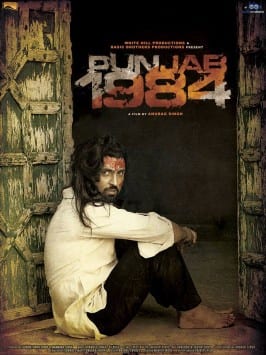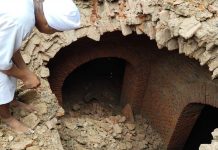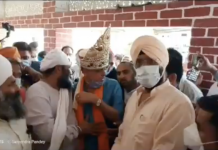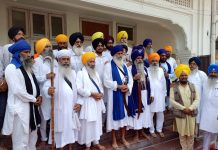

 I had the opportunity to see the film Punjab 1984. I almost decided not to go based on the reviews I saw online which claimed the film defamed the Khalistan movement and made Sikh fighters look like villains.
I had the opportunity to see the film Punjab 1984. I almost decided not to go based on the reviews I saw online which claimed the film defamed the Khalistan movement and made Sikh fighters look like villains.
I’m glad I went anyways. I found the film to be thoughtful and able to present a nuanced picture of what took place.
I feel that those who found the film to be offensive perhaps haven’t lived through those days or aren’t familiar with what happened and how. It could be a case of looking at the Movement with rose-colored glasses or trying to understand it as a simple binary of Good Guys-Khalistanis, Bad Guys-Punjab Police & Indian Government.
Things were never so simple.
—Punjab 1984 isn’t a propaganda film for the Khalistan Movement, nor should we have expected it to have been. That having been said, I believe the film is positive towards the Movement and Daljit’s character, Shivjit Singh (Shiv) is a strong protagonist.
Like the main character in the film, many of the young men who joined the Movement were initially not particularly ideological or often even all that religious. They were pushed into taking up arms by circumstances and the fact that there were few alternatives available to them.
The story in Punjab 1984 is one that happened all across Punjab. Family disputes, land disputes and other business disputes became thrown into and interwoven with the ongoing insurgency. Some people joined a Jathebandi to ensure their security or because a rival had joined another Jathebandi. In many disputes about money or land, one side paid the police to frame their rivals in order to get rid of them.
Shiv is one such young man. A neighbor takes advantage of the situation in Punjab to use the Punjab Police to intervene in a land dispute. Shivjit Singh is tortured and sent to be eliminated in a fake encounter by the corrupt police officer.
After escaping police custody Shiv joins a Kharku group whose leader (Sukhdev Singh) is fiery and speaks passionately about Khalistan but in his personal life he clearly is not a Gursikh. The leader, Sukhdev, engages in some actions which are clearly not justifiable according to Sikhi. In a scene depicting a meeting of Kharku leaders, there are serious disagreements and internal bickering.
That too is not an unusual story. Many prominent leaders of the Khalistan Movement such as Dr. Sohan Singh or Wassan Singh Zaffarwal have now been accused of being government moles who derailed the movement. It is a also an unavoidable reality that the Khalistan Movement was internally very divided and many leaders did not get along. The repeated formation and division of the Panthik Committees and the formation of countless splinter groups is a illustrative of that.
The plight of Shiv who does not agree with the way in which his leadership is taking the movement is also not unusual. In my discussions with families of young Sikhs who joined the Khalistan Movement for ideological reasons, I have been told more than once that the young Singh’s felt disappointed that not everything they saw was what they had expected or in accordance with the principles of Sikhi.
While many of us automatically assume that anything that went wrong in the Khalistan Movement was a result of government infiltration, the reality is not as simple. While government agencies heavily infiltrated the Khalistan Movement, there were many individuals who got involved for self-interest. There was a criminal element who took on the mantle of Khalistan to continue their pursuits. And there were those who may have got involved with good intentions but were corrupted along the way. Not every Kharku was a Gursikh or behaved in a way that was consistent with the principles of Sikhi. This element of the Movement cannot be dismissed simply as a fringe, but played a major part and was also instrumental in its failure. Punjab 1984 shows some of that reality.
Some commentators have expressed outrage that the film showed Hindus being killed by “kharkus”. In fairness, the killings in the film are carried out by goons who are clearly not ideologically motivated fighters. Such incidents are also unfortunately a reality of what happened in Punjab.
I have read some commentary which claims no innocent Hindus were ever killed by the Movement. I think that sentiment is actually a positive reflection, if not a misguided one, as it shows that Sikhs continue to abhor the killing of innocents.
In reality, the killing of Hindus and non-Punjabi laborers was not a one-off occurrence. Those involved in these killings were sometimes blinded by hatred and the argument that “Hindus” had killed Sikhs in Delhi and other cities in November 1984. There was also a strain of thought among some that driving Hindus out of Punjab would speed the formation of Khalistan. This angle has been covered by several books, including the novel Kundliay Sup by Amardeep Singh Amar, a very well known and respected Khalistani writer.
There have also been objections to the scene in which Shivjit Singh’s group’s boss is seen drinking with a politician. That scene is in fact quite powerful and reflects an important reality. The politician is connected to both the police and the kharkus and says that those who are too ideologically committed to Khalistan make the best fighters but the worst politicians. He says that even if Khalistan were to become a reality, it would be people like him who would make the government. The fact is that such politicians existed in the Sikh community in 1984 and continue to exist today who manipulate the community and Panthik sentiments for their own benefit.
The fact that these corrupt elements were drinking is hardly a shock.
Finally, some commentators have lamented that only the negative aspect of the Khalistan Movement has been shown and none of the spiritual Gursikhs who were involved were given any prominence. I would agree that the movie would have benefited from a character who was ideologically motivated to join the Khalistan Movement and was a spiritual Gursikh. That having been said, the absence of such a character is not a fatal flaw. This film cannot be expected to show every angle of the Movement in 2.5 hours.
Overall, the character of Shivjit Singh is a powerful one. It shows how young Sikhs were pushed into a fight that they had not wanted. It shows the confusion they felt, the obstacles they faced and the truly complicated world of the Khalistan Movement.
Rather than criticize this effort or trying to boycott it, it would be better for the community to take this film as an opportunity to reflect on the Movement and learn more. We should not be incensed when we are presented with the weaknesses of the Khalistan Movement. Not every personality involved in the Khalistan Movement or every incident that took place is one we need to defend. If we are to move forward as a community, we need to confront what went wrong and ensure we don’t repeat those mistakes.
Punjab 1984 is a thoughtful film. It requires reflection and nuanced analysis to fully appreciate. There is even some subtle symbolism and gentle nudges by the director if you are looking for them.
If you are looking for a pro-Khalistan propaganda film that presents only one side of the story, you may be disappointed.
I thoroughly enjoyed Sadda Haq but I enjoyed this film as well. Go to see Punjab 1984 with an open mind. It certainly cannot reflect the entire reality of the Khalistan Movement but it does an admirable job of showing some important features of it. Features that we may not feel comfortable confronting but will have to in order to progress.





There is no doubt that the freedom movement was infiltrated by govt agents but this occurred towards the end of the 80s and early 90s. The movie seeks to portray the period 1984-86 when the movement was on a sound ideological footing as evidenced by the declaration of Khalistan in April 1986. The movie appears to show the negatives of the movement as the norm and does not even touch on the majority of the militants who were inspired by the Shaheeds of June 1984 to take up arms against the tyranny of the Indian state. The movie takes up the infamous thesis of some so-called professors of a Punjab university whose ‘research’ showed that a majority of the kharoos took up arms for fun and because of boredom! Such motivated research is just one aspect of the multi-pronged govt strategy to downgrade the anguish that the 1984 generation of Sikhs felt at the govt massacre in June 1984 and present the new generation of Sikhs with a distorted picture of the movement. It is true that a movie of 2.5 hours cannot depict every aspect of the movement but the weakness of the movie is that it fails to bring out the major aspect or even the chief aspect of the movement.
This movie is specifically and intentionally anti-movement. This is the establishment retort to the grass roots support which has over the last 6 or 7 years been gaining ground in challenging decades of GOI propaganda.
This reviewer is also missing the point – thought and reflection upon what are anomalies rather than what truly characterised the period will lead you to the wrong conclusions. As an example the emphasis upon the killing of innocent Hindu civilians and the help offered to the mother by her Hindu friend do not characterise the reality of the situation, they are simply tools in trying to present some form of balance which frankly never existed. Did some Hindus help Sikhs? – undoubtedly some must have, were innocent Hindu civilians killed? – Again undoubtedly but were either of those situations common? Were these common occurrences? NO – so we must ask ourselves what would be the intention on focusing on aspects of the period that were in fact exceptions to the rule?
The intention is clear – to bring to prominence features which are detrimental to the understanding of the movement whilst at the same time towing the GOI line that this was largely a sectarian issue – which it was not.
Pakistan’s role is always overplayed by pro GOI commentators, whether in print or film. The fact is that Pakistan opportunistically supported the movement on the simple basis that ‘the enemy of my enemy is my friend’, no different than India’s support for Bangladeshi separatists – Pakistan did not create the environment which lead to Sikh grievances and they played no part in the GOI response to those grievances.
Remember it was not the Pakistani army that raided Sri Harmandir Sahib, it was not the Pakistani army that simultaneously attacked over 70 other major Sikh Gurudwaras in Panjab (one man-70+locations?) – It was not the Pakistani army that carried out mass murder and torture under the banner of ‘Operation Woodrose’, It was not the Pakistani army that desecrated more than 200 Gurudwaras in Delhi, It was not the Pakistani army that killed more than 3,000 innocent Sikhs in Delhi alone – this pattern repeated in at least 127 other northern Indian towns and cities (figures for those killed there may never be known) and it was certainly not the Pakistani army that burned Sikh chidren alive on the streets of the nations capital AND it has not been the Pakistanis who have for thirty years actively obstructed the prosecution of the guilty.
With regard to Hindu civilian killings in Punjab during the period – this is so often mentioned but very little offered in the way of facts. GOVERNMENT FIGURES, QUOTED BY DGP KS DHILLON IN AN ADDRESS TO A ICSSR SPONSORED CONFERENCE ON CONTEMPORARY HISTORY OF PUNJAB, HELD ON 27TH FEBRUARY TO MARCH 1ST 1995 – FOR THE PERIOD OF 1984 TO 1991 FIGURES IDENTIFY VICTIMS ACCORDING TO THEIR RELIGIOUS AFFILIATION – ACCORDING TO THESE STATISTICS THE NUMBER OF HINDU CIVILIANS KILLED FROM 84 TO 91 WAS 3,817.
So essentially the number of Hindu civilians killed for what was effectively the whole duration of the movement was approximately the same number of Sikhs killed within 2 days in Delhi alone – this is according to GOI figures, NGO’s double that figure – and remember this is just within the capital, we now know that the November pogroms carried on in over 120 other northern Indian towns and cities, numbers for Sikhs killed there is unknown and could run into further thousands.
ALSO – WHO WAS KILLING THE INNOCENTS?
It is open knowledge that the GOI employed so called ‘black cats’ – criminals often released from prisons to dress and appear as Sikhs of the movement, whose main goal was to terrorise the local population to defame the movement in order quell the peoples support – QUESTION HERE IS, IF THE MOVEMENT SIKHS WERE SO BLOODTHIRSTY, WHY DID THE GOI FEEL THE NEED TO INJECT CRIMINALS INTO THE MIX???
THE SIKHS CERTAINLY NEVER NEEDED TO DON INDIAN POLICE/ARMY DISGUISES TO COMMIT ATROCITIES TO SWAY THE PEOPLE – THEY DIDN’T NEED TO! ONLY CONCLUSION IS THAT THE MOVEMENT SINGH’S WERE FALLING SHORT IN THEIR TERRORISING OF CIVILIANS – WHILST THE ARMY/POLICE WERE NOT.
THERE ARE TWO SIDES TO EVERY STORY, INDIA HAS ITS VERSION OF EVENTS.
This is a comment that tries to suggest that their is somehow some parity
between the Sikh experience and that of the GOI or indian people, there is
no parity whatsoever. India was the aggressor and instigator, the vast
majority of civilian victims were Sikh, those imprisoned,raped and tortured
by the police and army were all Sikh, those disappeared, killed in
‘encounters’,
imprisoned for years without trial were and are Sikhs, bluestar desecrated
the most holy shrine of the Sikhs, all victims of the Nov pogroms were Sikh,
all those denied and still denied justice are Sikh.
There are opinion’s, some are based on facts whilst others are based on
misinformation, the propaganda that was used by the indian government to
justify bluestar and the subsequent ‘information’ issued through government
and army officials into the aftermath of the attack, such as numbers of
militants, numbers of dead, breakdown of men women and children, damage to
akal takht, numbers of arms, discovery of illicit drugs, troop casualties,
arson, removal of artefacts etc.etc.etc. have all subsequently been shown to
be lies, this is not a matter of opinion or open to debate they were
absolute, unashamed, downright, lies. How do we know this?
Because every single piece of information issued relating to the examples
above was later revised or in a number of cases completely denied.
As a small example the Indian’s originally issued a statement saying that
there were 49 militants taking shelter in Harmandir Sahib, Lt.Gen Brar later
offered these statistics “army casualties were 83 killed and 248 wounded;
terrorist and other casualties were 492 killed and 86 wounded” forward to the
24th May 2004 – speaking on the BBC programme ‘After Bluestar’ Lt.Gen. Brar put the number of militants at 2,000!
To further add to the confusion It is
noted that PM Rajiv Gandhi addressing the national union of students at
Nagpur in September 1984 referred to the 700 soldiers killed
executing bluestar. (I.Jaijee P.O.G.)
This endemic lying resonates throughout the entire period of insurgency in
the Panjab and continues to the present day.
The GOI has so twisted and distorted reality that there are those
who will contend that their are ‘two sides to the story’ without really
looking at the fact’s.
The idea that any individual act of barbarity, although unjustifiable is
comparable to the sustained, pre-meditated assault on an entire people,
employing the whole might of a national army, police and intelligence
networks, the use of all media by government to demonise the Sikhs both
nationally and internationally, the corruption of the judiciary, the
suspension of the rule of law, the passing of draconian legislation, the
legitimisation of extra judicial execution,the negation of the democratic process,the immunity from prosecution of the
guilty. In fact the entire machinery of the indian nation state was pitted
against one of its own minority communities, India had effectively declared
a war on the Sikh’s.
These actions as the action of choosing to perpetrate ‘bluestar’ on a
recognised day in the Sikh calendar belies the governments intentions. The
intention of GOI was to cause maximum Sikh civilian casualties. If not the
case then why June 6th? If not why hundreds of thousands of soldiers? If not why give
total immunity from prosecution to the police and army? If not why cut off all
communications, effectively turning Panjab into a open prison? If not why
expel all media,foreign and domestic? If not, why ban entry of UN or Human rights delegations to Panjab to this day?
ITS VERY SIMPLE IF YOU HAVE TWO PARTIES THAT DISAGREE IT IS USUAL TO ALLOW THE ENTRY OF AN IMPARTIAL THIRD PARTY TO LOOK AT THE EVIDENCE AND COME TO A CONCLUSION BASED ON THE FACTS – THE SIKHS HAVE BEEN URGING THIS TO HAPPEN FOR DECADES – UN SPECIAL RAPPORTEUR / AMNESTY / HRW ETC. – AND FOR DECADES INDIA HAS STAUNCHLY OPPOSED ANY THIRD PARTY OVERSIGHT, USING SIMPLE LOGIC WHO IS LIKELY TO BE TELLING THE TRUTH? THOSE THAT WANT IT EXPOSED OR THOSE WHO WILL DO ANYTHING TO HIDE IT?
I have noticed an increasing number of vocal apologists that talk about ‘moving on’ / ‘reflection’ / ‘don’t look at the movement through rose colored spectacles’
THE COMMUNITY THAT YOU HAPPEN TO HAVE BEEN BORN INTO HAS SUFFERED A TERRIBLE GENOCIDE AND THE STATE AND INDIVIDUALS ARE LIVING FREE WITHOUT ANY FEAR OF PROSECUTION WHILST DEFENDERS FROM THE VICTIMISED COMMUNITY ROT IN JAIL!! YOU TALK OF MOVING ON? YOU TALK OF REFLECTION?
Imagine for a moment that the Nurermberg trials never happened, the Nazi’s were never ousted, Israel was never created and men like Goering still held high positions within the German establishment whilst those Jew’s that took up arms against their persecutors languished in German prisons…..CAN YOU IMAGINE THAT JEWISH PEOPLE WOULD TALK OF ‘MOVING ON’? OF ‘REFLECTION’?
Even after the Nazis were exposed to the world, even after many of them faced trial and were hung, even after the creation of their own state, even after the worldwide recognition that they suffered a terrible genocide, even after they have erected museums so that the world should never forget, EVEN AFTER THAT – THEY CONTINUE TO PURSUE THE GUILTY!!
It is to me a terrible sense of shame when I hear people from our own community expressing these kind of sentiments – ‘move on’ / ‘reflect’ / ‘its been thirty years’ etc… I can do no better than the words of Thomas Paine written for those from his community whose sentiments were akin to ‘moving on’ etc….
“Your future connection with Britain/(see India), whom you can neither love nor honour, will be forced and unnatural, and being formed only on the plan of present convenience, will in a little time fall into a relapse more wretched than the first. But if you say, you can still pass the violations over, then I ask, Hath your house been burnt? Hath your property been destroyed before your face? Are your wife and children destitute of a bed to lie on, or bread to live on? Have you lost a parent or a child by their hands, and yourself the ruined and wretched survivor? If you have not, then are you not a judge of those who have. But if you have, and still can shake hands with the murderers, then you are unworthy of the name of husband, father, friend, or lover, and whatever may be your rank or title in life, you have the heart of a coward, and the spirit of a sycophant.”
—Thomas Paine
Common Sense (1776)
Satty- you display your vitriolic hatred of hindus by assuming Simran Kaur- is a Shilpha Sharma? So if someone does not hold to your dogmatic viewpoint, they cannot be a “Kaur” or a true ‘singh”? They are disguised hindus…..Interesting
The irony is that Sikh24 is more known for articles that take a more favourable view of the khalistani movement and the so called “shaheeds” (i call them militants but lets agree to disagree). And here you are decrying them for the opposite. An LOL moment if ever one
exactly what I had in mind after watching the movie. Your every word is true.
I would add that there is also commentary from reviewers who say that the movie is specifically anti-movement yet the main character Shivjit is an innocent sikh who is at last killed by the Punjab police. There are also scenes of the Punjab police mercilessly torturing individuals and creating fake police encounters. Those are all things that potray the reality of the 80s.
good movie
Well written. It is about the time to look at the bigger picture while continuing to be reminded of what happened at the grass root level (through art, literary and vocal efforts).
1984 will not happen ever again if Sikhs will continue to remember eventful years from 1975 through 2000. Only then will some of the biggest names in the Republic of India, in the profession of politics would stay cautiously afraid of existence of a power of “Sarbat Khalsa”. A power so subtle, so watchful, so interlocked, so complete, so pervasive, that they better not speak above their breath when they speak in condemnation of it.
great read, completely agree.
So true